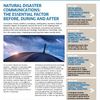By Mae Kowalke, TMCnet Contributor
This is the third in a series of blogs that have taken a look at natural disaster communications and how public safety organizations around the world a leveraging next generation communications to better prepare and respond to emergencies.
In this final installment, the focus is on the Canadian city of Calgary which had catastrophic flooding in June. But it also got lucky.
That’s because just as the worst flooding in the history of the city was overflowing the riverbanks and flooding downtown, taking down infrastructure as it went, Calgary was testing its new, next-generation IP/MPLS-based network infrastructure.
As its infrastructure was endangered by the flooding, the city’s IT team was able to move over to this new system and start the migration of 50 remote locations in a matter of hours, preserving its essential communications needed to deal with the flooding and preserve business continuity.
“The new network was in the testing phase,” noted a recent Alcatel-Lucent LifeTalk blog posting by the team that worked with Calgary. “The transition for getting everyone on it was supposed to take a year and a half. But in this case, the effort started happening immediately.”
The new network, while untested until the crisis, helped the city stay operational when it probably would not have otherwise, according to post.
“It validated that what we had planned, what we had received, what we had put in place – the redundancy and the resiliency,” noted the authors. .
Natural disasters are inherently chaotic an unpredictable. To enable natural disaster communications that can withstand such unpredictability takes a resilient network that’s secure, fluid and flexible – characteristics that are strongly supported by IP/MPLS.
Source: Alcatel-Lucent LifeTalk
“IP/MPLS immediately gives you the capabilities to integrate data, video and voice,” noted Steven Jennings, executive director of public safety for Alcatel-Lucent, in another recent LifeTalk posting on the subject. “It lets you load-balance all of your resources because it’s agnostic to the underlying transport technologies.”
He added: “It doesn’t really care about your network topology, whether you’re star or point-to-point, you can provision services rapidly no matter what is thrown at you, and it gives you common operational management and administration tools that work across the whole network.”
Emergency response personnel need to focus on the disaster at hand, not their equipment. And that requires a network that is robust enough.
The City of Calgary was lucky enough to have such a network in place when the flooding struck, aiding its natural disaster communications and ensuring that while it may have been the worst flooding in the city’s history, it didn’t need to be the most damaging.










